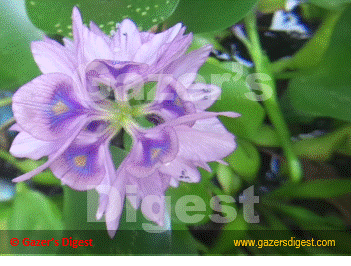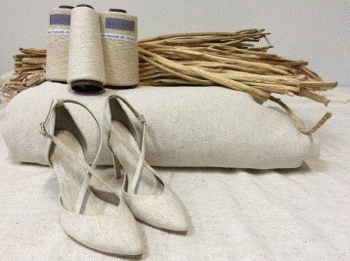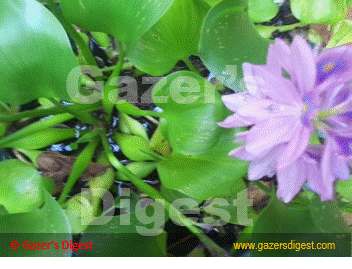
WATER HYACINTH—IT ADDS VALUE!
October 21, 2022
Water hyacinth ජපන් ජබර (Eichhornia crassipes) is a floating aquatic flowering plant. Its flower has beautiful purple-colored petals and a yellow spot inside a darker purple patch, on one petal. It can be found in freshwater environments in most regions of the world.
INVASIVE AQUATIC PLANT

Water hyacinth is one of the world’s most invasive aquatic plants. These aquatic plants grow rapidly and spread creating dense layers over the water surface. The dense layers of water hyacinth can take up the space on the surface of freshwater bodies, affecting other plants on the surface. The layers also prevent sunlight from reaching the vegetation below the water's surface.
Water hyacinth has been found to decrease dissolved oxygen concentrations. There is a negative relationship between dissolved oxygen concentrations and the percent coverage of water hyacinth. Dissolved oxygen concentrations were lowest in experimental ponds with 25% cover. However, oxygen concentrations in ponds with cover up to 25%, were adequate for the survival and growth of fish [1].
Water hyacinth layers interfere with boat navigation as well. A study, over three years (2018-2020), found that the hyacinth coverage in the Saigon River (Vietnam), was high during the dry season, from December to May, and the coverage peaked in February 2020 [2].
CREATIVE PRODUCTS

People in Sri Lanka's Dry Zone have helped keep water surfaces by making handicrafts from water hyacinth. People in the Mekong Delta region (Vietnam) have made handicrafts—rattan wares, from water hyacinth, since 2000 [3]. According to the faculty of Home Economics Technology at Rajamangala University of Technology Thanyaburi (RMUTT),Thailand; creative textile products can be made from Water Hyacinth [4].
BIOGAS & ORGANIC MANURE
Water hyacinth plants can be used in renewable energy (biogas) production. LPG and natural gas are fossil fuels. The water hyacinths in sewage lagoons are a rich source of nutrients. This aquatic plant can absorb nitrogen, phosphorus, potassium, and other minerals from domestic wastewater [5]. A study of water hyacinth as organic manure—chemical composition: potassium 1.35 %, calcium 1.85 %, nitrogen 2.56 %, phosphorus 1.90 %, organic carbon 33.0 %, magnesium 1.70 %, and iron 0.70 %—on the growth and yield of Lagos spinach, was conducted at an experimental site (pH 6.4-Slightly acidic) in Lagos, Nigeria. Toxic elements concentrations in water hyacinth—cadmium, lead, zinc, and nickel were allowed to reduce to the lowest levels. The results revealed that water hyacinth manure significantly increased the growth and yield of Lagos spinach [6].
PHYTOREMEDIATION

Water hyacinths have been used to treat industrial wastewater. The water hyacinth plant’s absorption capacity has been validated in several studies. Water hyacinth plants can absorb heavy metals බැර ලෝහ and chemicals from certain types of industrial wastewater [4]. In a laboratory-based experiment, researchers from Bayero University Kano tested the water hyacinth plant’s capacity to absorb pollutants in wastewater from Kaduna Refinery and Petrochemical Company; and found that water hyacinth can be used effectively to reduce the pollutants in the wastewater [7]. The research was carried out in Indonesia, to test the water hyacinth plant’s ability to reduce pollutants in batik wastewater. The results showed that water hyacinth reduced ammonia by 78.36 % and chromium by 63.76 % [8]. Water hyacinth in the Sacramento-San Joaquin Delta, in California contained the same mercury concentration as the underlying sediments, suggesting that plant harvesting could aid the remediation of mercury contamination [9].
REFERENCES
- McVea, C. Boyd C. E. (1975) Effects of Waterhyacinth Cover on Water Chemistry, Phytoplankton, and Fish in Ponds Journal of Environmental Quality Volume 4, Issue 3 p. 375-378
- Niels Janssens et al 2022 Environ. Res. Lett. 17 044069
- Viet Nam News (2019) Making use of water hyacinth
- Billy C. Wolverton, & McDonald, R. C. (1979). The Water Hyacinth: From Prolific Pest to Potential Provider. Ambio, 8(1), 2–9
- RMUTT (2016) Professors from RMUTT’s Department of Textiles and Garments Develops Natural Fibers from Water Hyacinth
- Sanni, K.O. and Adesina, J.M. (2012) Response of water hyacinth manure on growth attributes and yield of Celosia argentea L (Lagos Spinach). Journal of Agricultural Technology 2012 Vol. 8(3): 1109-1118
- Ugya, A.Y. and Imam, T.S. (2015) The Efficiency of Eicchornia crassipes in the Phytoremediation of Waste Water from Kaduna Refinery and Petrochemical Company. IOSR Journal of Pharmacy and Biological Sciences (IOSR-JPBS) e-ISSN: 2278-3008, p-ISSN:2319-7676. Volume 10, Issue 1 Ver. IV (Jan -Feb. 2015), PP 76-80
- Bunyamin Muchtasjar et al (2019) The Ability of Water Hyacinth (Eichhornia crasipes Mart.) and Water Lettuce (Pistia stratiotes Linn.) for Reducing Pollutants in Batik Wastewater, E3S Web Conf., 226 (2021) 00010
- Ben K. Greenfield, Geoffrey S. Siemering, Joy C. Andrews, Michael Rajan, Stephen P. Andrews, Jr and David F. Spencer (2007) Mechanical Shredding of Water Hyacinth (Eichhornia crassipes): Effects on Water Quality in the Sacramento-San Joaquin River Delta, California

Home | Contact: info@gazersdigest.com
© 2020-2025 Gazer’s Digest is an information sharing platform. Gazer’s Digest includes topics, thought to be useful for the readers.